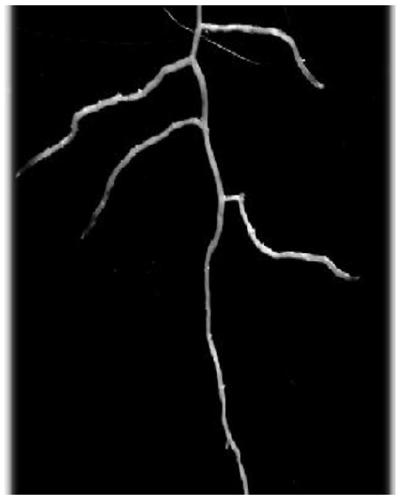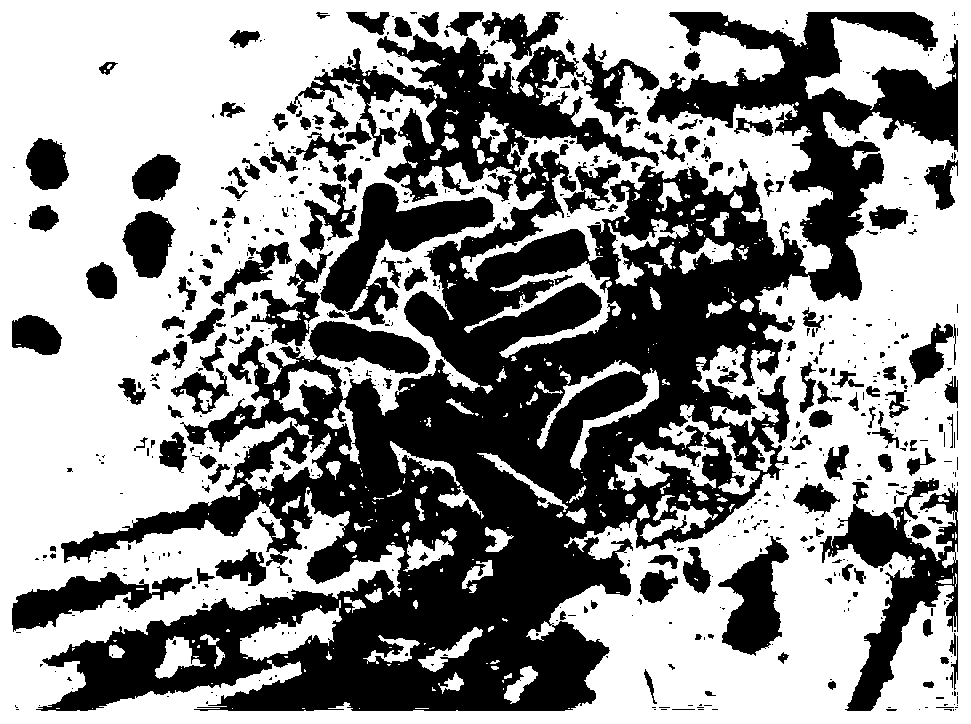Method for preparing paeonia plant root tip chromosome slice
A technology for chromosome preparation and Paeonia lactiflora is applied in the field of chromosome preparation at the root tip of Paeonia lactiflora, can solve the problems of large influence of preparation results, high requirements for preparation conditions, influence on karyotype analysis results, and the like, and achieves low cost , Expand the range of materials, and increase the effect of the concentration of hydrochloric acid
- Summary
- Abstract
- Description
- Claims
- Application Information
AI Technical Summary
Problems solved by technology
Method used
Image
Examples
Embodiment 1
[0034] (1) Material collection: 1-1.5 cm of the white root tips of new roots germinated in autumn from the vigorously growing peony ‘Xishi Fen’ seedlings in the field were excavated from 9 to 11 in the morning in late September 2019 (by figure 1 shown), put it into a container filled with clean water and bring it back to the laboratory, and the time from the next step of processing should not exceed 2 hours.
[0035] (2) Pretreatment: Clean the removed root tips, put them into a saturated aqueous solution of p-dichlorobenzene, and pretreat them for 3.5 hours under refrigeration at 0-4°C.
[0036] (3) Fixation: Rinse the pretreated root tips three times with distilled water, blot dry, and place them in newly prepared Carnot’s fixative solution (absolute ethanol: glacial acetic acid = 3:1) at 0-4°C for refrigeration. Fixed for 22-24 hours.
[0037] (4) Dissociation: Rinse the fixed root tip three times with distilled water, blot dry the water, put it into a dissociation solutio...
Embodiment 2
[0045](1) Materials collection: 1-1.5 cm of white root tips of new roots germinated in autumn from the vigorously growing peony 'Fengdan' seedlings in the field were excavated from 9 to 11 in the morning in late September 2019 (by image 3 shown), put it into a container filled with clean water and bring it back to the laboratory, and the time from the next step of processing should not exceed 2 hours.
[0046] (2) Pretreatment: Clean the removed root tips, put them into a saturated aqueous solution of p-dichlorobenzene, and pretreat them for 3.5 hours under refrigeration at 0-4°C.
[0047] (3) Fixation: Rinse the pretreated root tips three times with distilled water, blot dry, and place them in newly prepared Carnot’s fixative solution (absolute ethanol: glacial acetic acid = 3:1) at 0-4°C for refrigeration. Fixed for 22-24 hours.
[0048] (4) Dissociation: Rinse the fixed root tip three times with distilled water, blot dry the water, put it into a dissociation solution with...
Embodiment 3
[0056] (1) Material collection: From 9 to 11 in the morning in late September 2019, dig out 1 to 1.5 cm of the white root tip of the new root of the peony 'Kao' seedling that grows vigorously in the field in autumn, put it in a container filled with clean water and bring it back In the laboratory, the time to the next step of processing should not exceed 2 hours.
[0057] (2) Pretreatment: Clean the removed root tips, put them into a saturated aqueous solution of p-dichlorobenzene, and pretreat them for 3.5 hours under refrigeration at 0-4°C.
[0058] (3) Fixation: Rinse the pretreated root tips three times with distilled water, blot dry, and place them in newly prepared Carnot’s fixative solution (absolute ethanol: glacial acetic acid = 3:1) at 0-4°C for refrigeration. Fixed for 22-24 hours.
[0059] (4) Dissociation: Rinse the fixed root tip three times with distilled water, blot dry the water, put it into a dissociation solution with a volume ratio of absolute ethanol and ...
PUM
| Property | Measurement | Unit |
|---|---|---|
| length | aaaaa | aaaaa |
Abstract
Description
Claims
Application Information
 Login to View More
Login to View More - R&D
- Intellectual Property
- Life Sciences
- Materials
- Tech Scout
- Unparalleled Data Quality
- Higher Quality Content
- 60% Fewer Hallucinations
Browse by: Latest US Patents, China's latest patents, Technical Efficacy Thesaurus, Application Domain, Technology Topic, Popular Technical Reports.
© 2025 PatSnap. All rights reserved.Legal|Privacy policy|Modern Slavery Act Transparency Statement|Sitemap|About US| Contact US: help@patsnap.com



